Train Turntables
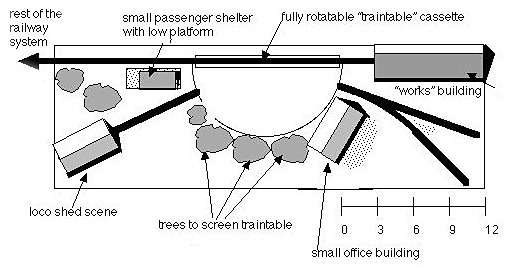
Apple Valley Light Railway is Ian Holmes’s delightful application of his lazy susan turntable/cartridge idea. Designed for Gn15 trains that Ian uses, the same layout would work fine for On30, O16.5, HOn3, HOn30, or OO9!
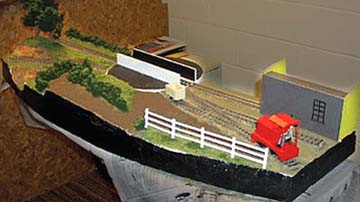 Ian’s ideas for the layout are clear from his notes on the plan above, and from this “work in progress” photo of the Apple Valley. For more recent progress, check Ian’s web site.
Ian’s ideas for the layout are clear from his notes on the plan above, and from this “work in progress” photo of the Apple Valley. For more recent progress, check Ian’s web site.
Notice that the turntable, based on a lazy susan kitchen carousel, has a removable cassette in place. To change trains or cars, Ian simply lifts off the cassette and replaces it with another containing a different consist.
As indicated on the plan, the turntable will eventually be hidden behind a screen of trees. In a small space, the Apple Valley Light Railway provides a great many operational possibilities!
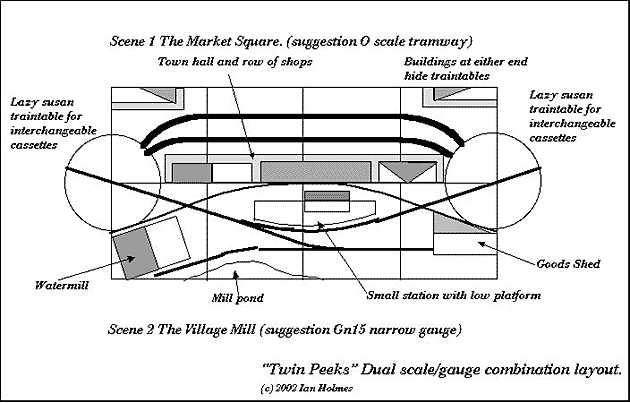
Ian Holmes continues to build on his lazy susan technology by introducing a back-to-back concept: two micro layouts that share a pair of train cassette turntables — Twin Peeks. Because the cassettes can be swapped in and out, these two point-to-point layouts can be made in different scales and even different gauges. You get two layouts in the space of one!
By way of illustration, Ian has drawn up a pair of 1’x4′ (30×120 cm) micros. Scene 1 at the top is a Market Square served by a busy O scale tramway (trolley line). Because cassettes are so easy to swap on the turntables, the Square provides railfans with an amazing variety of trams (trolleys) passing by daily! Carefully planned “stopping sections” can insure an ongoing lineup of fascinating rolling stock going in both directions.
Scene 2 is a Gn15 narrow gauge line (1:24 scale trains on 16.5mm gauge) serving a small village that features a mill (complete with pond and millrace) and a goods shed (freight house). This little line operates tiny switching locos and four-wheeled rolling stock, so a turntable cassette can hold an entire train of three cars and locomotive. A variety of rolling stock passes by during the course of a typical day.
In this particular example, the cassettes can also be dual-purpose, with four rails to hold trains of either gauge. But perhaps the best part is this — you can operate one concept for awhile, and then for a change of pace turn the layout around and run a completely different concept — no waiting! This idea promises to become a real crowd pleaser at exhibitions.
The Big Turnaround Runaround
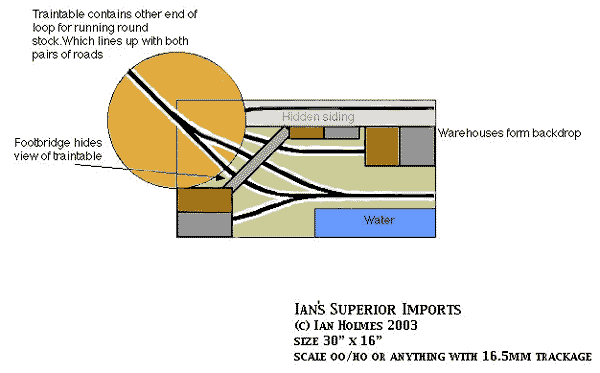
Ian Holmes continues to explore train turntables with Ian’s Superior Imports — here he brings the runaround loop right up onto the turntable and makes it do double duty as a headshunt for two sidings! Ian claims this idea was brought forward by Iain Rice a few years back, but it was certainly new to me!
Ian sees the traffic on this ingenious little line like this: “I envision the layout being OO scale using LNER J70 (Toby the Tram) and Y10 locomotives with their skirts and cow catchers for visual interest. But anything with 16.5mm track will work.” This layout could be built in HO, OO, On30, O16.5, 1:32n21, or even Gn15!
Lots of switching keeps the little engines busy, as they draw cars from the hidden siding, make up trains on the turntable, enter the layout, and shunt the visible sidings using the runaround — including the hidden end on the turntable! Track patterns are not as simple as they look, and this little line can keep two operators busy for some time. And this is one layout where everyone who sees it will want to inspect the backstage area!
Scenery is suggested as a waterfront, but it could be set anywhere, in virtually any country. Standard Peco turnouts and flex track are used, so this is a relatively easy layout to put together. A little more complex than a beginner’s railway… but not too difficult!
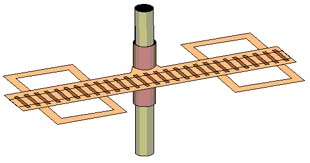 Taking Emrys Hopkins’ design of the 3-D Sector Plate to another level, so to speak, Jon Songøygard has imagined the 3-D Train Turntable (at right). What’s more, he’s put it to excellent use in the Knife and Fork Railroad plan!
Taking Emrys Hopkins’ design of the 3-D Sector Plate to another level, so to speak, Jon Songøygard has imagined the 3-D Train Turntable (at right). What’s more, he’s put it to excellent use in the Knife and Fork Railroad plan!
This two-level plan for either HO/OO standard or narrow gauge, features a high-level mine with a simple approach track on a slight downhill grade to the 3-D Train Turntable. Once on the turntable, the train is turned 180 degrees and brought down to the lower level, where it continues on its way to the wharf with the locomotive still on the proper (downhill) end of the train.
At the “0 cm” level, the loads of ore (or coal or whatever) are dumped into a scale-length barge, for eventual transport to the rest of the eagerly waiting world. Note that the lower level trackage is in the form of the classic Fork pattern, allowing easy shunting of the wharf. Headshunt (switching lead) length can be adjusted to suit your rolling stock. Empties return to the mine by reversing the operations.
Notice that Jon, who lives in Norway, has provided for handles at both ends of the Turntable to make it easy to turn. You’ll also need “landings” at each end on both levels, to add stability and to support the weight of the train. The Knife & Fork would make an excellent display railroad for exhibitions, being simple to build and easy to operate. Separation between levels is an arbitrary height … if you love vertical scenery, make it even higher! (If headroom is limited, the elevation of the upper level can be reduced as well.)
Important construction note: when constructing the attachment between the track board and the vertical pivot tube, make sure there’s enough clearance at the side of the track to allow your widest rolling stock to wheel freely from end to end. Current can be connected using wire in tube sockets at each end of the turntable , with matching wire “plugs” on each rail of the main baseboard connecting trackage.
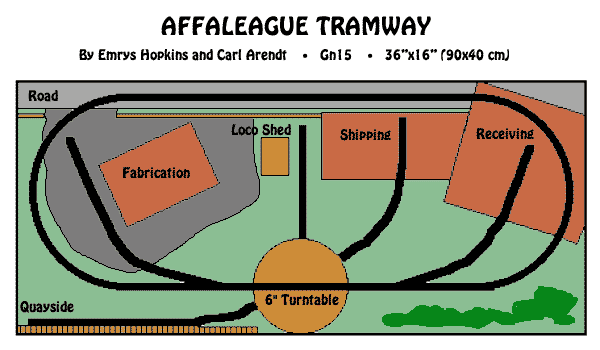
Affaleague Tramway is a tiny narrow-gauge railway (could be Gn15, or On30/O16.5, or HO traction) that serves the Affaleague Athletic Footwear factory somewhere in Micronesia. It began as a somewhat-larger project of Emrys Hopkins for a Gn15 layout. He moved on, and I asked if I might rework it as a micro layout, because I was intrigued by one specific and unusual feature: the turntable, which occupies the “main line” takes the place of a runaround track to serve sidings facing in either direction!
So this little 6″ turntable actually is a “train turntable” in that a locomotive and at least one car will turn on it to shunt spurs facing the “wrong” way. Operations can be pretty complex, and at least two company switch engines can be kept busy on this little tramway. This line can be home to virtually any critters, from Australian homemade bush switchers to Plymouths and Rustons–long as they can round those 6″ radius curves.
Raw materials (rubber, fabric, eyelets, laces, etc.) arrive by water and are unloaded at the quay. The tram picks up cargo there twice a day and hauls it to the Fabrication Shop and the Receiving dock, via the turntable. Items to be shipped will be picked up at Shipping and delivered to the Quayside or leave through the gate and disappear down the road. If a fiddle yard is desired, it would be reached from the side, through the factory building that contains the Receiving dock.
There’s also the fascinating possibility of making this a 360-degree layout — one that can be viewed “in the round”. All that’s required is to declare that all shipments depart via the Quayside, and the road becomes a scenic asset rather than a route to the fiddle area. Your choice. I like the way the turntable works hard to help this little tramway operate.
A Truly Dynamite Layout
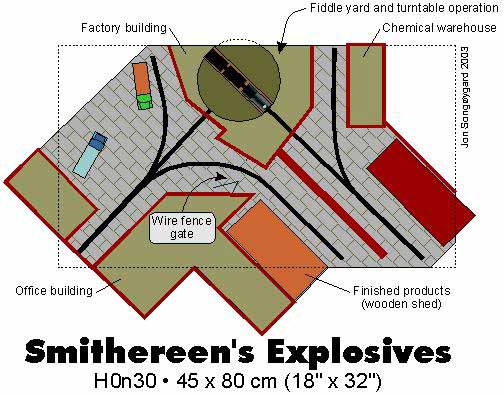
Jon Songøygard, who lives in Norway, originally developed the tramway at Smithereen’s Explosives to fit in a 80×45 cm rectangle (32×18 in – shown dotted). But he discovered that the design worked much better scenically if he let the buildings extend over the boundaries of the baseboard and made the layout an irregular shape. As often happens, he obtained a more interesting looking layout in about the same area.
Here the train turntable is hidden inside the factory building and serves as both a fiddle yard and an integral part of the industrial tramway’s route. The operator can change train consists, perhaps using removable cassettes on the turntable, from the back of the factory building. The rest of the layout is viewable by spectators — about a 270 degree visual path.
Jon explains the operations: “The ‘outside world’ enters at the left side of the layout, where the train interchanges with lorries (trucks). Here the necessary chemicals are carried ‘carefully’ onto the train, which then moves inside the factory building (with the train turntable). Some of the chemicals are stored in the brick building at the upper right (out of the danger area for the workers).
“Finished products are stored in the wooden shed (lower middle). This shed is built to collapse easily if the stuff inside should ignite. The heavy red line pointing to the lower right corner represents a thick brick wall, built to catch a possible outburst from the shed. There’s a wire fence gate between the two largest buildings, to keep people off the plant’s non-public areas.
“Thus there are traffic movements from the lorries to the chemical warehouse; from the chemical warehouse into the factory; from the factory to the wooden shed; and from the wooden shed to the lorries.” This tramway does not lack work to do!
Rolling stock must be kept short. Jon measured a Roco loco and two wagons, to make sure that every track on the drawing — including the turntable — can hold that much equipment. Although the plant doesn’t actually require them all, up to eight wagons could find running room on this layout at the same time — keeping the operators both busy and nimble!
Meet the ‘Translating Turntable’!
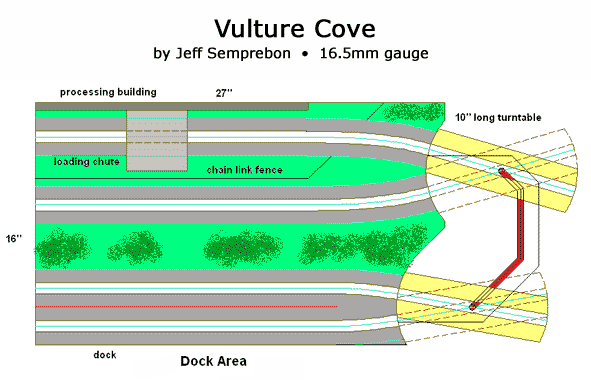
Jeff Semprebon, who lives in New Hampshire, expands the innovative uses of train turntables with this fascinating plan for a “translating turntable”. It’s called Vulture Cove (or “Cala del Buitre”), and is intended as a winter retreat from outdoor railroading in 7/8n18 scale …. so it’s set in a semi-tropical location! Dimensions shown are for the 16.5mm gauge version — either Gn15 or On30 scales — measuring 27×16 in (60×40 cm). Double those dimensions for 7/8″ scale.
Jeff describes the plan this way: “The turntable should be just long enough to hold a small critter and two dump cars. I suppose a longer turntable could be used without much modification. The pivot point of the turntable slides in a track, indicated in red, allowing it to serve all four tracks while cutting out much of the length that would be needed for lead tracks to reach a stationary turntable.
“Gravel or ore cars are loaded at an overhead chute on the side of a processing building (a low-relief model at the rear), then switched to the front track of the dock, where they can be dumped into a bucket representing a barge (from which they are eventually dumped back in a supply hopper feeding the loading chute).
“The back track on the dock can be used for shunting cars or for loading supplies to be taken to the third track, which presumably leads off to the gravel pit/mine. A row of weedy trees separates the dock from the area behind it, although other view blocks might be used; perhaps a derrick for loading supplies, some form of shed, etc. The combination of a partial view block in front and the chain link fence in back hopefully is sufficient to distract the viewer from realizing that the train operations are serving to move the bulk material a rather short distance.”
A lot of operation … in a very small area … due to Jeff’s innovative “translating turntable.” If you decide to take advantiage of this space saving idea, please take photos and send them to me so everyone can learn from your experiences!
Introducing: The Haigh ‘Pivot Table’
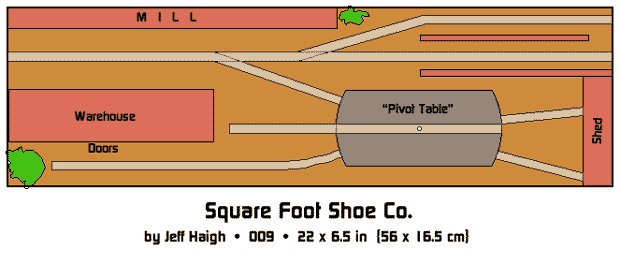
Jeff Haigh, who lives near Northampton, England, has created a variation on the train turntable that may prove useful in a variety of micro layout designs. He calls it a “Pivot Table” and is building the Square Foot Shoe Co. to show it off. Scenery makes clever use of commercial buildings and low-relief models to represent an industrial scene in Jeff’s home area, which is a traditional centre of shoe manufacturing.
This 22×6.5 inch OO9 layout (4mm scale on 9mm gauge) was designed to fit on a bookshelf. It is intended to show lots of rolling stock in action, without any need for fiddling in the offstage yard (at the upper right). Jeff can accommodate three locomotives and seven pieces of four-wheeled rolling stock on this tiny tramway. It’s less than a square foot in area, thus the name (with a glance back at my Squarefoot Estate Railway that occupies about the same acreage in Gn15 scale).
The main feature of the layout is the Pivot Table, which sits front and center. It is built from a Peco N-scale turntable, with the pit cut off on each side. The table cannot rotate 360 degrees — instead, it pivots from side to side to release the trains into various sidings. The table will hold a loco and two four-wheeled cars (as shown in the photo below).
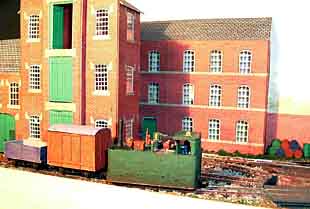
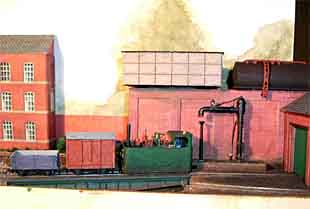
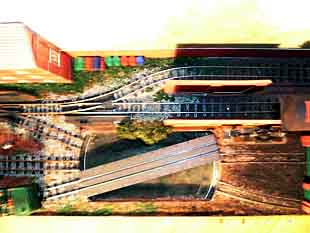 Operation involves a loco pushing two cars from one of the sidings representing the “rest of the world” (upper right), pulling the consist onto the Pivot Table, and shoving it into the front siding, spotting the cars at the loading doors of the Warehouse. The loco might then retire to the Shed for water and fuel, or return with the cars it has collected from the Warehouse.
Operation involves a loco pushing two cars from one of the sidings representing the “rest of the world” (upper right), pulling the consist onto the Pivot Table, and shoving it into the front siding, spotting the cars at the loading doors of the Warehouse. The loco might then retire to the Shed for water and fuel, or return with the cars it has collected from the Warehouse.
Another loco emerges from the other hidden siding and repeats the operations via the pivot table, first collecting the “loaded wagons” from the warehouse, then spotting the new cars in front of the doors. Either loco — or a third unit that hangs out by the Shed — can return the “loads” to the hidden siding, ready to repeat operations later on.
The layout uses plenty of stock, features varied but leisurely operations, and requires very little real estate (less than one square foot). Jeff has certainly used his Pivot Table to excellent advantage!
And It Comes Out … Where?
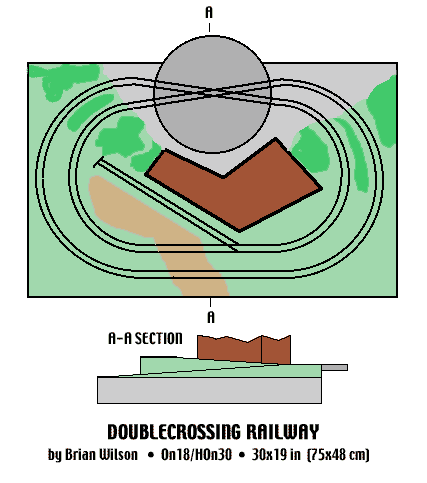 Brian Wilson, from British Columbia, Canada, has invented a new “wrinkle” for the train turntable — a crossing on the table itself! The result: four different routes by which the train can exit the hidden table — “the train goes round and round , and it comes out — where?”
Brian Wilson, from British Columbia, Canada, has invented a new “wrinkle” for the train turntable — a crossing on the table itself! The result: four different routes by which the train can exit the hidden table — “the train goes round and round , and it comes out — where?”
He calls it the Doublecrossing Railway — you never quite get what you expect!
Brian’s notes on the layout ran as follows:
” Left in place, the turntable provides a twice around continuous run. Otherwise, there are four possible exits. “Place your bets, Ladies and Gentlemen!!” Then there is a new twice around continuous run. For switching the siding, the turntable could be rotated for a run-around track.
“I have shown it with a 9″ diameter turntable for On18. Of course for HOn30 the diameter could be less. If a fellow were really careful, it could be made with a 12″ diameter for On30 or Gn15. The turntable would be hidden by either a scenic divider or under a hill.”
As shown in the cross-section view, Brian has suggested a 2″ elevation difference between the inner and outer tracks (at the front of the layout). This height difference can accentuate the separation between the tracks and heighten the illusion of mystery as a train disappears on one track and reappears on another — going in the opposite direction!
As with some of the other train turntables on this page, the unit could easily be made from a Lazy Susan, a kitchen turntable device readily available in kitchenware stores.
And operation? This little pike is loaded with it! Trace out a few of the routes a train can take in loading at the siding, hauling way the loaded cars, bringing back empties, etc. Here are just a few of the possibilities that Brian sketches out:
“It seems to me that the crossing/turntable would be a way to double the distance travelled or provide an ‘out and back’ operation — 1.5 circuits out and 1.5 back. Other possibilities could include loads-in/ empties-out using two trains — one open box car and one closed might do the trick; or using the turntable with the inner circuit for a runaround to switch the siding.
“Also there may be enough space to have a couple of sidings off the turntable in the centre of the layout for other equipment (maybe a railbus or other engines). Rather than hiding the crossing/turntable under a hill, it could be inside a building. If the engine sidings were included, the view from the front of the layout could be towards the back of an engine house and the main siding would service a car shop.”
I’ll bet, as you study Brian’s clever idea, a half-dozen more great ideas will occur to you. Then get busy and build one (don’t forget to send in photos!).
[To see more of Brian’s actual model work, check out his website.)
